 Maddie balances on a thin log while crossing a creek about a mile from camp on day one.
Maddie balances on a thin log while crossing a creek about a mile from camp on day one. After driving six or so hours from Bellingham to the Hoh Rainforest Campground in Olympic National Park, I was happy to be out of the car and stretching my legs. It was still early morning, and while I and the three guys I was with finished securing our ice axes and helmets to our packs and lacing up our boots, other campers filtered in and out of the bathroom, paying little attention to us.
As we started to make our way to the trailhead, I fell briefly behind the boys, trying to untangle my headphones, and by the time I’d caught back up, they had been stopped by a chatty older man leaning over the bed of his white Ford F250. He noticed me approaching, quickly did the math in his head as I stopped to join them, and blurted out, “Oh, there’s a girl?”
I want to say that it escaped his mouth before he could stop it, mostly by the way that he cheesed up his smile when I met his eyes. He had a short white beard, leather skin and a provolone grin. And he held eye contact when I acknowledged him.
As we left the parking lot and headed into the woods, I tried to brush the comment off, but it stuck with me, like a nagging in the back of my head as we fell into the brisk pace that would get us through the next 15 miles to camp.
The boys and I were there to summit Mt. Olympus, the glaciated and most prominent peak in the Olympic Mountains. At 7,969 feet, it’s a baby compared to its volcanic neighbors, about 3,000 feet lower than Mt. Baker. However, unlike Baker, Olympus is hidden in the middle of the Olympic Rainforest.
The approach just to the Blue Glacier on the north side of the mountain involves about 18 miles of wet, gray, hiking along the Hoh River, which is enough to deter many from summiting it. Jeff Smoot, in his “Climbing Washington’s Mountains,” mentions the “blisters, cramps, and shoulder-strap bruises” that come with the “trudge up the trail to the base camp at Glacier Meadows,” then the aches and pains of the next day’s summit. All this suffering for a mountain you can’t even point out on a clear day; it was mythical in that way, and I wanted to be on top of it more than anything else.
But several miles into the trek and I couldn’t shake the old man’s observation. That’s the thing about it: It wasn’t insulting, so I couldn’t get mad about it. It was simply just a fact. I was the only girl of the group, and apparently it was noticeable. Noticeable in a way that made me self-conscious.
I began to get anxious. Suddenly, I felt like I had to prove that I could be there. But it wasn’t like I was accomplishing anything new or great by being part of that team. I was certainly far from the first woman to summit Mt. Olympus, but as any woman in the climbing and mountaineering world knows, it’s an uphill battle to be seen as equal in the sport. Mountaineering was originally a man’s sport; in fact, Albert F. Mummery, an early English mountaineer in the Victorian era, gave Alp Mountains three difficulty levels: inaccessible peaks, the hardest climbs in the alps, and an easy day for a lady. Mummery believed that once a mountain had been summited by a woman, it was no longer considered difficult. Though much has changed in terms of equality in the sport since then, it’s hard not to notice the small remains of that belief that’s been left behind in the mountaineering community.
And, to make matters worse, I became increasingly self-conscious that one of the guys in our team was my partner. I started to question my own sanity: Am I just the girlfriend along for the ride?
By the fifth mile, my mind was set: I had to prove myself. I was not going to be just the girl or the girlfriend, I was going to keep up, no, out-do my male counterparts.
So, I picked up my pace. No matter how quickly they hiked, I was right on their heels. I jumped at the opportunity to filter water for the group during our breaks at the river. I traversed slick log crossings without giving away my nervousness. I made a point to swallow my tiredness and not let it surface.
Even after making it to camp, my feet throbbing and swollen from the 15-mile trek, I made sure to pull my fair weight by helping pitch the tent, filter more water from the river and boil it for our freeze-dried meals. You know, all the tasks that any helpful team member does to help the operation go smoothly. But, paranoid, I assumed all eyes were on me to see if I would step up and do so or if I was going to let the boys pamper me.
 The two rope teams take a brief break near the middle of the Blue Glacier as fog rolls in.
The two rope teams take a brief break near the middle of the Blue Glacier as fog rolls in.The next day, summit day, was much of the same: I pushed myself to keep up and keep quiet. This time, with the elevation gain, I couldn’t keep the exhaustion and nerves from creeping up into my face at each new obstacle. I kept my concerns to myself over having to descend the long, wooden ladder that was suspended just off the ground all the way down a massive landslide that carried away the trail in 2011. It tipped and wobbled like a rope course in a waterpark with each step I made.
After the ladder, we crossed what was left of a melting snow bridge over a creek. In my wobbly post-ladder daze, I stepped onto a thin piece of snow and went crashing through into the creek. In my fall, I caught my thumb between my trekking pole and a large rock. I yelled out in pain and immediately regretted it, pushing my partner away when he rushed over to help me. Desperate to escape the situation, the embarrassment of my poor decision, I dashed out in front of him and into the woods. There, I felt my chest tighten, and I caught my hands on my knees. Overwhelmed, I thought to myself, you can’t do this. Not here. Not now. Not as the girl.
For the rest of the climb, my thumb throbbed with my heartbeat, quickening as we went up and up and up. On the glacier, we passed by foot-wide crevasses and through thick, white-out mist until the base of the final climb to the summit. The last 150 feet consisted of a low-fifth class rock climb. I followed behind the boys.
It seemed fitting that the top of that hidden mountain that the horizon would be nowhere to be found. Dense clouds filled in the space where the Hoh rainforest, the Pacific Ocean and the land on the eastern horizon should have been. And to everyone below us, we were invisible, non-existent. It felt bittersweet to know that the old man from the parking lot would never see that I did it, that I kept up all along. But, in those moments, before our rappel back onto the glacier, the top was just for me and the boys who probably didn’t care that I was a woman all along. X